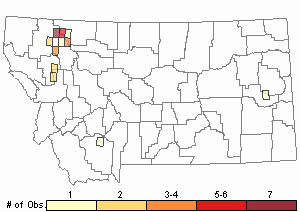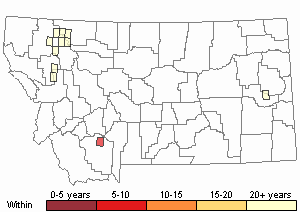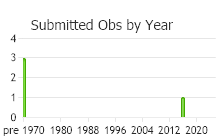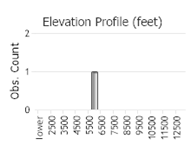View in other NatureServe Network Field Guides
NatureServe
Montana
Utah
Wyoming
Idaho
Wisconsin
British Columbia
South Carolina
Yukon
California
New York
Starke's Kiaeria Moss - Kiaeria starkei
General Description
Plants: Acrocarpous. Growing in open clumps of erect shoots, green, sometimes yellow, usually glossy. Stems simple, 1-4 cm tall; rhizoids few near the top of the stem (FNA 2007).
Leaves: Typically strongly curved and pointed to one side, the ends curled when dry, 2-4.5 mm in length, lance-shaped, narrowing steadily to a subula; margins upright, smooth, finely saw-toothed (FNA 2007) or smooth apically; costa excurrent, the protruding awn scruffy with papillae (Lawton 1971).
Leaf Cells: Margins 1 cell-layer thick above (FNA 2007); alar cells typically brown (Lawton 1971), quite swollen, very distinct from the neighboring square cells; lower laminal cells somewhat long, smooth, occasionally pitted; upper laminal cells 2-4:1, sometimes nearly square, a little scruffy with mammillae; costa with stereid cells scarcely differing from the guide cells (FNA 2007).
Diagnostic Characteristics
The similar K. blyttii has dull leaves that are not falcate-secund. K. falcata tends to grow on level rather than vertical rock. K. starkei differs from them both with its distinctly grooved capsules when dry (FNA 2007). The sessile perigonia located close to the perichaetia is a dependable characteristic of the species (Crum & Anderson et al. 1981).
Range Comments
North American Range
AK, BC and AB s to OR, ID and MT, MB, QC, NL and NS, NH (FNA 2007). Known in Montana from Flathead, Glacier, Lake, and Lincoln Counties (Elliott & Pipp 2016).
Observations in Montana Natural Heritage Program Database
Number of Observations: 31
(Click on the following maps and charts to see full sized version)
Map Help and Descriptions
Relative Density

Recency



 (Observations spanning multiple months or years are excluded from time charts)
(Observations spanning multiple months or years are excluded from time charts)
Habitat
Noncalcareous stone or soil in stone fissures, often on precipitous stone faces; high elevations (FNA 2007).
Reproductive Characteristics
Autoicous, the stalkless perigonia situated immediately beneath the perichaetia (FNA 2007). Seta 5-10 mm tall (Lawton 1971), seldom to 15 mm, yellow, darkening to deep red (Crum & Anderson et al. 1981). Capsule bowed, swollen at the base (Lawton 1971), conspicuously grooved when dry; theca 1.3-2 mm in length; peristome with 16 2-lobed teeth, the lobes reaching to mid-tooth, russet, with papillae or longitudinal grooves. Calyptra draping like a hood (FNA 2007).
Stewardship Responsibility
References
- Literature Cited AboveLegend:
 View Online Publication
View Online Publication Crum, H.A. and L.E. Anderson. 1981. Mosses of Eastern North America. 2 volumes. Columbia University Press, New York. 1328 pp.
Crum, H.A. and L.E. Anderson. 1981. Mosses of Eastern North America. 2 volumes. Columbia University Press, New York. 1328 pp. Elliott, J.C. and A.K. Pipp. 2018. A Checklist of Montana Mosses (1880-2018). Updated 3 January, 2020. Montana Natural Heritage Program, Helena, Montana. 73 pp.
Elliott, J.C. and A.K. Pipp. 2018. A Checklist of Montana Mosses (1880-2018). Updated 3 January, 2020. Montana Natural Heritage Program, Helena, Montana. 73 pp. Flora of North America Editorial Committee, eds. 2007. Flora of North America North of Mexico. Volume 27. Bryophytes: Mosses, Part 1. Oxford University Press, Inc., NY. xxi + 713 pp.
Flora of North America Editorial Committee, eds. 2007. Flora of North America North of Mexico. Volume 27. Bryophytes: Mosses, Part 1. Oxford University Press, Inc., NY. xxi + 713 pp. Lawton, E. 1971. Moss Flora of the Pacific Northwest. Hattori Botanical Laboratory. Japan: Yamabuki-cho, Shinjuku-ku, Tokyo. 362 pages plus appendices.
Lawton, E. 1971. Moss Flora of the Pacific Northwest. Hattori Botanical Laboratory. Japan: Yamabuki-cho, Shinjuku-ku, Tokyo. 362 pages plus appendices.
- Additional ReferencesLegend:
 View Online Publication
View Online Publication
Do you know of a citation we're missing? Elliot, J. C. 1993. Second checklist of Montana mosses. Unpublished report. U.S. Forest Service, Region 1. Missoula, MT. 45 pp.
Elliot, J. C. 1993. Second checklist of Montana mosses. Unpublished report. U.S. Forest Service, Region 1. Missoula, MT. 45 pp. Lawton, E. 1971. Keys for the Identification of the Mosses on the Pacific Northwest. Reprinted from 'Moss Flora of the Pacific Northwest'. Published as Supplement No. 2 of the Journal of the Hattori Botanical Laboratory. Nichinan, Miyazaki, Japan. 66 pp.
Lawton, E. 1971. Keys for the Identification of the Mosses on the Pacific Northwest. Reprinted from 'Moss Flora of the Pacific Northwest'. Published as Supplement No. 2 of the Journal of the Hattori Botanical Laboratory. Nichinan, Miyazaki, Japan. 66 pp. Malcolm, B., N. Malcolm, J. Shevock, and D. Norris. 2009. California Mosses. Nelson, New Zealand: Micro-Optics Press. 430 pp.
Malcolm, B., N. Malcolm, J. Shevock, and D. Norris. 2009. California Mosses. Nelson, New Zealand: Micro-Optics Press. 430 pp. Smith, A.J.E. 1980. The Moss Flora of Britain and Ireland. Cambridge University Press, Cambridge. 705 pp.
Smith, A.J.E. 1980. The Moss Flora of Britain and Ireland. Cambridge University Press, Cambridge. 705 pp.
- Web Search Engines for Articles on "Starke's Kiaeria Moss"





